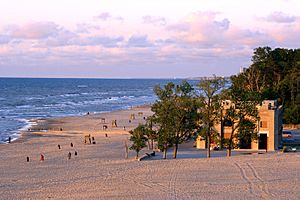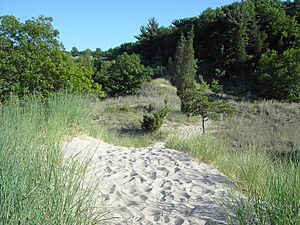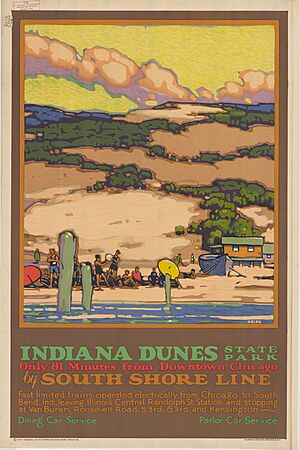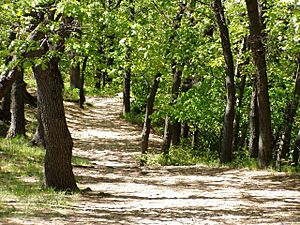Indiana Dunes State Park facts for kids
Quick facts for kids Indiana Dunes State Park |
|
|---|---|
 |
|
| Type | State Park; National Natural Landmark |
| Location | Porter County, Indiana, United States |
| Nearest city | Chesterton, Indiana |
| Area | 2,182 acres (883 ha) |
| Created | 1925 |
| Operated by | Indiana Department of Natural Resources |
| Visitors | 1,367,194 (in 2018–2019) |
| Status | Open all year |
| Website | Official Website: http://www.in.gov/dnr/parklake/2980.htm |
Indiana Dunes State Park is a cool place to visit in Porter County, Indiana, USA. It's about 47 miles (75.6 km) east of Chicago. This park sits right next to Lake Michigan and is surrounded by the bigger Indiana Dunes National Park.
The park is famous for its amazing dunes, which are big hills made of sand. A large part of the park, about 1,530-acre (619.2 ha), is a special area called the Dunes Nature Preserve. This preserve has most of the park's hiking trails and beautiful dune landscapes.
Indiana Dunes State Park was created in 1925. It became a National Natural Landmark in 1974, which means it's a very important natural place. Like other state parks in Indiana, you need to pay a small fee to enter. In 2018–2019, it was the most visited state park in Indiana, with over 1.3 million people coming to explore!
Contents
How the Dunes Were Formed
The awesome sand dunes at Indiana Dunes State Park were made by strong winds blowing off Lake Michigan. When the wind carrying sand hits plants, hills, or other dunes, it slows down and drops the sand. Over a very long time, this process builds up the huge dunes you see today.
After the last Ice Age, the water level of Lake Michigan dropped. This made the shoreline move back, and new dunes started to form closer to the lake. Plants began to grow on the older dunes, and eventually, forests grew on top of them.
Sometimes, you can find "blowouts" in the dunes. These are spots where the wind has blown away the sand, revealing old, dead tree stumps that were once buried. The most famous blowout here is called Big Blowout.
A Look at Park History

The idea to save the Indiana Dunes started a long time ago. People realized how special this area was and wanted to protect it.
In the early 1900s, many people worked hard to make the dunes a protected area. They wanted to save this unique landscape from being developed. Their efforts led to the creation of Indiana Dunes State Park in 1925. This was a big step in protecting this natural wonder for everyone to enjoy.
Cool Things to See and Do
Indiana Dunes State Park offers many exciting activities and sights:
- Sand Dunes: Explore the massive sand dunes, some of which are very tall.
- Singing Sand: Listen closely! Sometimes, the sand here can make a "singing" or squeaking sound when you walk on it.
- Smelt Fishing: During certain times of the year, people enjoy fishing for small fish called smelt.
- Haunted Shores: Hear the local legend of Diana of the Dunes, a mysterious woman said to have lived among the dunes.
- Birdwatching: The park is a fantastic place to spot many different kinds of birds.
- Hiking: There are miles of trails to explore, from easy walks to challenging climbs.
Park Facilities and Activities
The park has great facilities to make your visit fun and comfortable:
- Swimming and Sunbathing: There's a public swimming beach with lifeguards during summer. The rest of the beach is perfect for sunbathing or looking for shells. Dogs are allowed on the non-swimming parts of the beach if they are on a leash.
- Beach House: You'll find a beach house with snacks and drinks during the summer.
- Observation Platform: Climb up to the platform near the top of Mt. Tom. On a clear day, you can even see the city of Chicago in the distance!
- Birdwatching Tower: There's a special tower on Trail 10 where you can watch birds over a marsh.
- Nature Center: This building is open all year. It has a window to watch wildlife, a library, and a large room for programs. Park naturalists lead hikes and teach visitors about the park.
- Picnic Shelters: Enjoy a meal outdoors at one of the picnic shelters.
- Hiking Trails: The park has 16 miles (26 km) of trails. They go through sand dunes, past old buildings, and through wet prairies.
- Guided Hikes: Join a park ranger for a guided tour to learn more about the dunes.
- Cycling: While not all areas allow bikes, the Calumet Trail runs through the park. This trail lets you bike within the park and connect to nearby areas.
- Arts and Crafts: Sometimes, the park offers fun arts and crafts activities.
- Camping: The campground was updated in 2004. It has 140 campsites with paved spots, electricity, and picnic tables. There are also new shower houses and restrooms. A short path leads from the campground to the swimming beach.
Dunes Nature Preserve
| Dunes Nature Preserve | |
|---|---|
| Designated: | 1974 |
The Dunes Nature Preserve covers about two-thirds of the state park, around 1,530 acres (620 ha). You can only explore this special area on foot. All eight of the park's hiking trails go into the preserve. These trails offer experiences from easy walks to tough climbs among the dunes.
Highlights of the preserve include:
- The Tremonts: These are the three highest dunes in the park. They are Mt. Tom (192 feet (59 m) above lake level), Mt. Holden (184 feet (56 m) above lake level), and Mt. Jackson (176 feet (54 m) above lake level).
- Blowouts: You can see large blowouts like Beach House Blowout and Furnessville Blowout.
- The Marsh: This wet area has a bird observation tower, perfect for spotting different bird species.
- Trails:
- Trail 8 is 1.5 miles (2.4 km) long. It takes you over all three of the high dunes, starting from the Wilson Shelter and ending at the beach.
- Trail 10 is the longest at 5.5 miles (8.9 km). It's considered a moderate trail. It starts at the beach and goes east along the shoreline. You'll pass Beach House Blowout and Furnessville Blowout. The trail then goes into the dunes through an area called Paradise Valley, following a creek and passing through the Pinery and along the marsh. You can reach the Bird Observation Tower from this trail. Trail 10 ends at the Nature Center.
The preserve was named a National Natural Landmark in 1974. It also has the Ancient Pines Nature Area, which is an old forest that has been uncovered by the wind blowing away the sand.
Understanding Blowouts
Blowouts are cool features formed by the strong winds coming from Lake Michigan. The wind picks up sand and piles it into dunes. As dunes grow, plants like beach grasses start to grow on them. These plants have strong roots that hold the sand in place, making the dune stable. Over time, other plants like sumac and juniper also grow, creating a protective layer over the sand.
A blowout happens when this protective layer of roots and plants gets a "nick" or a break. This can be caused by animal trails, people walking, or even a tree falling over. Once the open sand is exposed to the wind, the wind starts to move it again. It can dig under other roots and carry the sand away.
If the winds are strong enough, a large blowout can form. This can reduce the height of the dunes in a big area. The three biggest blowouts in the park are Beach House, Furnessville, and Big Blowout. Big Blowout has even uncovered an area of dead tree trunks, which is known as the Tree Graveyard.
The park also has a special Youth Tent Area for groups, separate from the main public campground.
Images for kids





